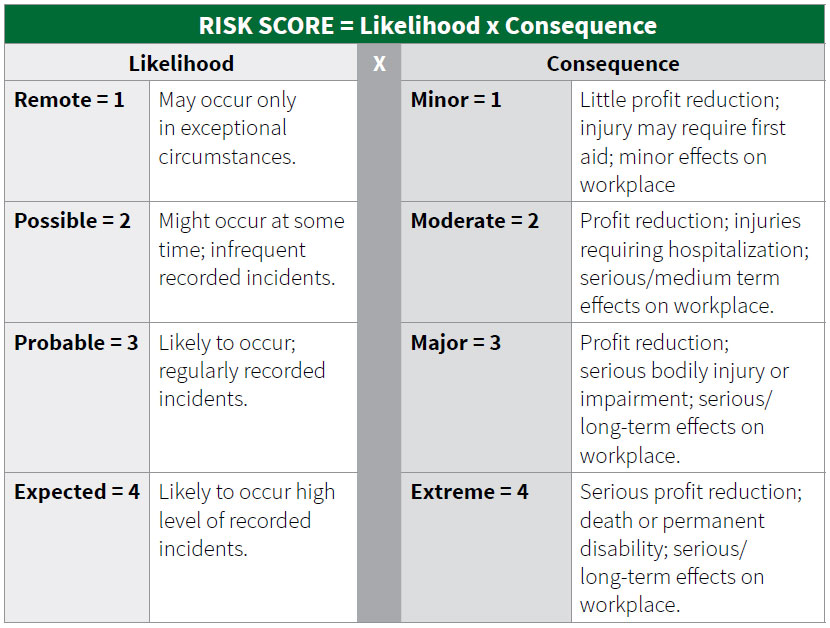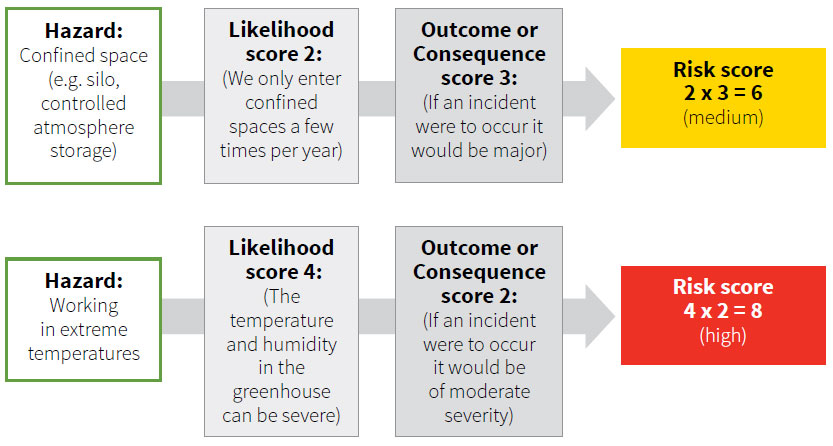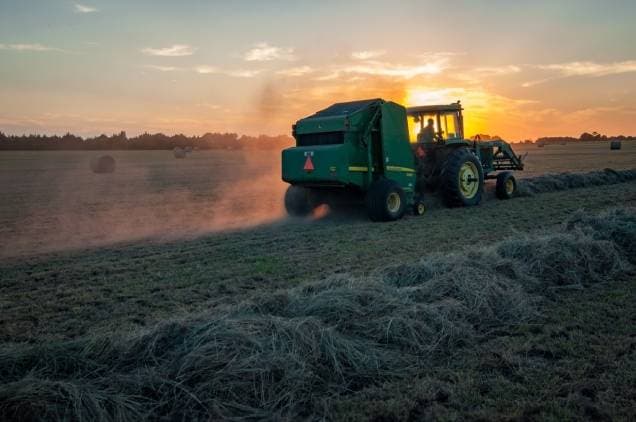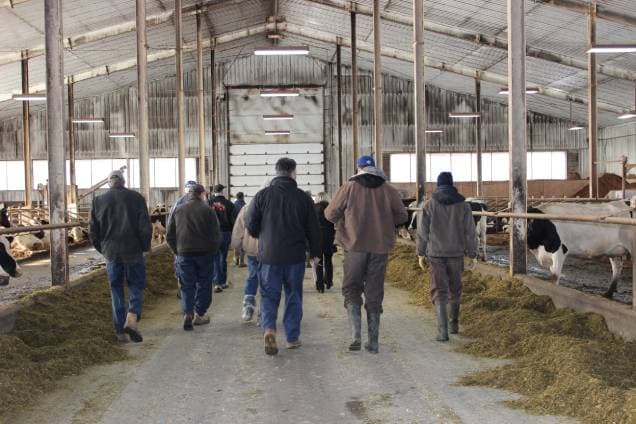
Section Three: Identifying Hazards and Knowing the Risks
Workbook
Understanding Farm Hazards
To do:
- Identify the hazards on your farm
- Develop a hazard identification program
In this section we will go over the importance of identifying the potential hazards on your farm and assessing their risks. After understanding and identifying the risks on your farm, the following section will provide information on how you can control the hazards you’ve identified in order to keep everyone safe.
It is well known that farming is a hazardous occupation and that you aren’t able to eliminate all hazards and risks. But the important part is identifying those hazards and understanding the risk involved. Once identified you are able to work safely around those hazards by implementing the proper controls. Know your farm – know your hazards – know your controls!
It’s impossible for you or your employees to work safely around hazards if they are not acknowledged and managed.
Hazards can cause injury or negatively impact your health or the health of your employees. Identifying hazards is the first step in managing them. There are two types of hazards: health and safety.
HEALTH HAZARDS
Health hazards – may endanger a worker’s physical health. They may take time to show an impact.
SAFETY HAZARDS
Safety hazards – could cause bodily injury or property damage. They often have an immediate impact.
Health Hazards
(Source: Small Business Safety Toolkit, Nova Scotia)
Chemical: Includes any form of chemical, such as compressed gases, sanitizers, fertilizers.
Physical: Includes noise, vibration, heat, cold, and radiation.
Ergonomic: Includes design of the workplace and jobs that involve repetition, force, and posture e.g. milking, packing lines.
Biological: Includes organisms or toxic substances produced by living things that can cause illnesses or disease in humans, such as bacteria, viruses, fungi, parasites, and insects.
Different tasks and processes on the farm will involve multiple hazard types – you need to look at the big picture and consider all types and factors contributing to hazards.
Safety Hazards
(Source: Small Business Safety Toolkit, Nova Scotia)
Machine: Includes hazards from moving parts like rotating shafts, belts, pulleys, blades, tractors and stationary equipment.
Energy: Includes pneumatic or hydraulic pressure, steam, heat, and electricity.
Material Handling: Includes manual and mechanical handling—lifting, lift trucks, conveyors.
Work Practices: Working unsafely, as a result of either safe work practices not being in place or failure to follow them.
Five Key Factors Contributing to Creating Hazards
(Source: Small Business Safety Toolkit, Nova Scotia)
There are many contributing factors to creating or increasing the risks of hazards.
People: Action, or lack of action, can create workplace hazards. Knowledge and training is critical to avoid unsafe behaviours. Solid leadership that puts health and safety top-ofmind can help ensure safe work practices and procedures are followed.
Equipment: Tools and machines can be hazardous. Look for unsafe or unhealthy conditions, such as inadequate guarding or barriers; defective tools and equipment; incorrect tools and equipment for the job; or inadequate warning systems.
Materials: Some materials, such as hazardous chemicals, pose a hazard in and of themselves. In other cases, handling materials improperly or using the wrong material for the task can pose a hazard.
Environment: Some hazards are created by the work environment. Look for things like the condition of all work surfaces and walkways; overcrowding; poor ventilation; poor lighting; extreme temperatures or noise; or poor housekeeping.
Process: Process involves a combination of people, equipment, materials, and environment. It includes design, organization, pace, and type of work. By-products created by the process may be hazards, such as heat, noise, dust, vapours, fumes, and
scrap materials.
Identifying Hazards
There are a number of ways to identify the hazards on your farm. All employers are responsible for identifying the hazards that exist at their workplace/farm. For larger farms with over 20 employees there is a requirement to develop a hazard identification program. A hazard identification program is simply the outline of the process and schedule to be followed on your farm.

Find a template for a hazard identification program within your workbook.
While a formalized hazard identification program may not be required for smaller farms, it is absolutely critical to know and identify any potential safety issue on your farm in order to keep everyone safe. There are a number of methods by which you can identify hazards on your farm. You should pick the options that work best for you.
Identify Hazards through Workplace Inspections
Source: Small Business Safety Toolkit, Nova Scotia)
Employers, managers, health and safety representatives, and workers can—and should—participate in workplace inspections. Inspections are one of the most common and effective tools for identifying and correcting hazards before they cause injuries or illnesses.
You can also use inspections to draw attention to and encourage good health and safety practices. Regular workplace inspections are an important part of your overall occupational health and safety system. Inspections let your workers know that you care about workplace safety.
Workplace inspections include both formal inspections and informal inspections.
Formal inspections are planned, regularly scheduled walkthroughs or examinations of a workplace, selected work areas, or sources of potential hazards, such as machinery, equipment, tools, and work practices. Use an itemized checklist to guide a formal inspection. The primary advantage of formal inspections is that a record is kept and any hazards identified are documented for action and follow up.
Create a workplace inspection checklist to clarify inspection responsibilities, plan and control inspection activities, and provide a report of inspection findings. Checklists permit easy, on-the-spot recording of findings and comments. Be careful, however, that your inspection team does not become so intent on filling out the checklist that they miss other hazardous conditions. Use a checklist as a tool, not as an end in itself. Keep the focus on workplace safety.

Example inspection checklists are included in your workbook.
Use them as a guide to create an inspection checklist specific to your farm.
Informal inspections are a conscious awareness of health and safety hazards and controls as people do their daily jobs. They differ from formal inspections in that they do not necessarily rely on a checklist, and they are not regularly scheduled.
Informal inspections can be done for a specific work area or task. They are limited because they are not systematic or focused, but they may spot potential hazards. The advantage of informal inspections is that anyone can do them at any time. Letting your workers know that informal inspections are a part of everyone’s daily business gives each worker permission to speak up about hazards.
Identify Hazards through Task Analysis
Task analysis is a key method for recognizing potential hazards. It is a structured approach of breaking a task down into steps, looking for hazards at each step, and developing ways to eliminate or control the hazards to prevent injury.
TIP
It is best to involve your workers when doing a task analysis. They are the people most familiar with the tasks. They are most likely to have insight into the tasks that a casual observer may not notice. A thorough task analysis involves five steps:
- Select the task to be analysed;
- Identify the steps involved in that task;
- Identify and rank potential hazards at each step;
- Determine how to control the hazards; and
- Write a safe work procedure.

For a more detailed look at task analysis – including a closer examination of each step involved – refer to your workbook.
Identify Hazards through Observation
Hazards may be identified through observation—by anyone at your workplace. You can think of observation as being aware of your surroundings in the normal course of your day and noticing something out of the ordinary.
Listen to your workers
When a worker raises a concern about something they’ve observed, attend to it immediately. Determine if there is a hazard and whether controls need to be put in place or improved. Provide your workers with an easy forum to report hazards. A simple report form can be made available for workers to fill out and submit or it could be done verbally.
Workers and others in the workplace should report any hazards immediately. Encourage the reporting of “near misses” as well. If you notice a worker seems uncomfortable or concerned when completing a task, ask them why. Then make sure their concern is heard and acted upon.

Refer to your workbook for an example hazard report form.
Visitors provide a fresh perspective
Sometimes a casual observation by a visitor or another fresh set of eyes can point out something you may not have noticed.
TIP
Identifying hazards on the farm can seem like a large daunting task. You need to break it down into manageable steps.
- Identify the tasks performed on the farm (e.g. pruning, milking, welding).
- Perform a task analysis on each task – start with the more hazardous tasks first.
- Identify the equipment and products use on the farm.
- Conduct an inspection of the equipment and products to ensure they are safe working condition (according to manufacturer’s specifications).
- Identify the task associated with the equipment and products.
- Perform a task analysis on each task – start with the more hazardous tasks first.
Risk Assessment
Once a hazard has been identified, employers need to assess the hazard by the degree of risk posed to the farm’s workers or visitors – this process is typically called a risk assessment. The reason for completing a risk assessment is to help prioritize the order in which you will address these risks. The next section of this workbook will help you determine the controls to put in place to protect workers and visitors from these hazards after completing the assessment.
Risk assessment
Risk assessment – process to identify, evaluate and prioritize hazards and risks.
Hazard
Hazard – any source of potential damage, harm or adverse health effects.
Risk
Risk – the chance or probability that a person will become harmed or experience an adverse health effect or that potential damage will occur, if exposed to a hazard.
When determining the degree of risk to workers, you must consider the consequence and impact of exposure (e.g. injury or illness) along with the likelihood of occurrence.
The easiest way to conduct a risk assessment is to assign a risk score to the hazard.
A risk score can be calculated using the following system:

TIP
Ask yourself the following questions when determining likelihood: has this hazard caused an incident before, either on your farm or a neighbour’s? How often has it happened? Could a similar incident happen again?
Ask yourself the following questions when determining the consequence: If an incident were to happen, what would be the outcome? Would there be a serious injury or fatality? Would it cause severe damage to equipment or property? If you know of past incidents, how serious was the outcome?
Have a look at your incident records (more on this in section 5) to help you
determine the risks associated with the hazards on your farm.
Example Assessments

Example Risk Assessment Matrix

Low Risk (1 – 2): They are risks of less significance and should be managed accordingly.
Moderate Risk (3 – 6): These risks are also significant and should be addressed following high risk items.
High Risk (8 – 16): These risks are critical risks requiring immediate attention. They must be treated as high priority.

Refer to your workbook to complete your risk assessment.


